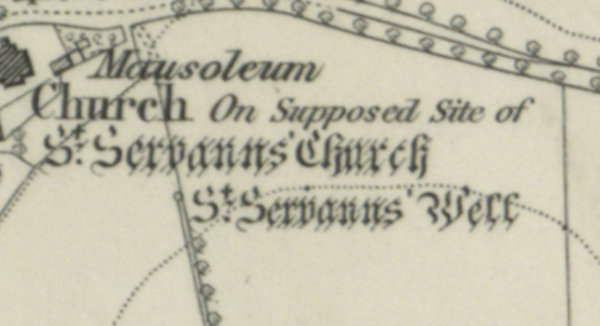 |
Dedication: Saint Serf Location: Alva Coordinates: 56.154663 , -3.7909654 Grid reference: NS888972 Heritage designation: none |
HOME - SCOTLAND - CLACKMANNANSHIRE
 |
Dedication: Saint Serf Location: Alva Coordinates: 56.154663 , -3.7909654 Grid reference: NS888972 Heritage designation: none |
St Servana, known now more commonly as St Serf, was a 6th century saint who travelled to Scotland from Rome and became the centre of many legendary accounts. According to one of these stories, he brought up St Mungo after Mungo's mother, St Theneva, was thrown off a cliff (luckily she survived unharmed) when her family discovered that she was pregnant. He likely spent time preaching in the area around Alva, and possibly founded the parish church, which bears his dedication. In fact, local legend has it that Servana himself performed a miracle at the site of the well.
The well itself was first mentioned in a charter of 1276, in which Sir Alexander of Striveling granted one acre of his land to God, the Virgin Mary, St "Servanus", and the church of "St Servanus de Alveth". In this charter, which was originally written in Latin, the piece of land was described as being "inter ipsum fontem et ecclesiam" (between the spring and the church); by this time, the well was evidently important enough as a local landmark to be used to identify a the location of a particular plot of land.
During the Victorian era, the well was referenced by several historians. Despite the fact that, for the first few decades of the 19th century, the well was located in part of an open field, the spring was soon encroached upon and eventually surrounded by the local cemetery. Whilst the well was marked and named on the first edition Ordnance Survey map of the area (see the main image), subsequent editions leave out the well. The well is said to have had healing powers of some kind, although the exact details of these have been lost. It appears that the well was mostly forgotten by the local community following the Reformation, as is stated in The New Statistical Account of Scotland: Dunbarton, Stirling, Clackmannan (1845):
|
The well is still within the limits of the minister's glebe, and continues to send forth a stream of excellent water; but the course is almost choked up with weeds and rushes; the consecrated name has long been forgotten; and its neglected state calls loudly upon the tutelar saint, or some Catholic devotee, to rescue its name from oblivion, and disclose again its healing virtues. |
As the cemetery expanded, the well was eventually covered and, according to OS surveyors in 1950, encased in "a modern concrete block", seemingly as part of the cemetery's drainage system. Today, although the well is still capped, the area of scrubland around the site of the spring is reportedly rather marshy.
|
Access: The capped spring is located right next to the cemetery, down a public road. |
Images:
Old OS maps are reproduced with the permission of the National Library of Scotland
Copyright 2025 britishholywells.co.uk